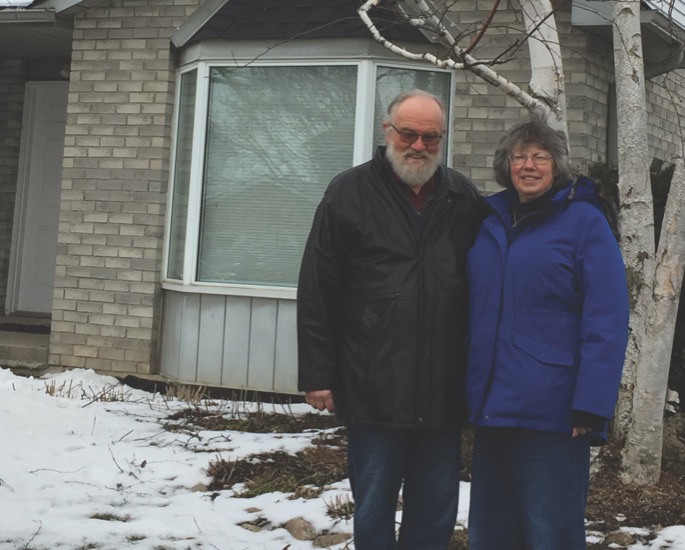
By Mike Renzella
The Haldimand Press
CALEDONIA—Caledonia resident Pat Hussack and her husband are in a jam. They want to downsize from their large home in to a single-story retirement-friendly house, but they can’t find anything in town that fits the bill.
“My husband and I have lived in Caledonia for over 30 years and this is where we want to live in our retirement. However, there is a distinct lack of adult community housing in this town,” said Pat.
She said she was initially happy when the Avalon development was announced, until she visited their information centre: “I was shocked to find there are only two-story family homes available in the survey. Ourselves and some of our neighbours are at the stage in life where we would like to downsize from our three- or four-bedroom, two-storey with a basement homes.”
Hussack described her ideal residence as single-story, with main amenities available on the first floor for ease of access, and a garage and basement large enough for adequate storage, noting the difference between active retirement living and living in seniors housing.
“It’s what we want and we want to stay in Caledonia,” she said. She spoke of some of the adult active-living tailored options in Dunnville, Simcoe, Binbrook, and Port Dover, and wondered why similar options did not figure heavily into planned developments in the Caledonia area.
Shannon VanDalen, Manager of Planning and Development for the County, explained the County’s role in deciding what type of housing is included in new developments: “Planning and zoning does not directly address the type of residence or the style of a house.”
She continued, “In fact, ‘people zoning’ is prohibited in the planning process. Over the last number of years, the municipality has seen more multi-unit condo developments constructed, including townhouse, free-hold single detached, and apartment units, which are often attractive to seniors due to smaller size, lack of maintenance, etc…. Much of the building and house design is left to the developer and to the purchaser. Many of the developers and builders have various housing options to pick from and the demand or request from the market is what is being constructed.”
As a major developer in the county, The Haldimand Press asked Empire Communities about the style of housing chosen for new developments, and why there aren’t more options like the ones Hussack hopes to see. A response was not provided prior to publication.
VanDalen brought up a change made to the County’s Comprehensive Zoning Bylaw in 2020 that allows for a more streamlined process for those looking to build garden suites or secondary suites on existing properties to double as homes for seniors looking to live close to family or as an option for personal support: “If a property owner meets the zoning provisions for criteria such as size, setbacks, access, parking etc., they can apply right to a building permit.”
While she said there has been interest in the provision, statistics were not readily available to demonstrate how widespread that interest may be overall.
VanDalen added that although the County cannot dictate what types of housing are ultimately built, they do advocate for a mix of different housing types and forms.
“Planning policies are being drafted to address the need for more affordable and attainable housing. Ultimately, it is up to the developer and purchaser as to what units are available for the development,” said VanDalen.
Haldimand has a policy requirement that states 20% of new residential units must be built within existing neighbourhoods in each of the County’s urban centres, which is largely accommodated through in-filling lots or higher density uses on vacant parcels of land.
“This often translates to higher density units closer to amenities and services that lends well to this population segment. Given this policy requirement and the need for the County to meet that 20% target, it serves to give some leverage for the County to influence certain housing styles.”
Haldimand County is anticipated to grow by approximately 30,000 people over the next 30 years. According to VanDalen, the changing demographics will demand a “variety of housing forms”, with a greater mix of semi-detached and townhouse units factoring into plans. Historically, the single-detached style has been Haldimand’s most common form of housing.
“In recent years, there have also been a number of applications for apartment buildings and low-rise condominium developments,” she added.
According to a Growth Analysis to 2051 report filed to the County by Watson and Associates Economists Ltd. in September 2020, the rising cost of housing prices will drive a significant portion of Haldimand’s future population into “higher density” housing, including walk-up apartments, triplexes, and low-rise apartments.
The report forecasts the percentage of Haldimand’s 55+ population to increase from 30% in 2016 to 35% in 2046, noting there will be an “increasing need” for homes that range from independent living to assisted living and full-time care. VanDalen added, “On the other hand, a growing wave of new Haldimand County residents will be seeking housing opportunities that are geared towards active lifestyles and recreation.”
It’s clear that Haldimand residents will need to make some necessary adjustments across all age categories over the coming decades as the population of not only the county, but the province as a whole, experiences growing pains. None of that helps Hussack, or others in her age range in Caledonia looking for active living choices.
“There are many reasons why Caledonia should be more retirement friendly. The town should want to keep people willing to volunteer as they have done in the past for many organizations and service clubs,” summed up Hussack. “Grandparents babysit, they fundraise for important projects in town, shop in town supporting local business … and importantly, pay taxes. We want to stay here where we have friends and the beautiful Grand River.”





